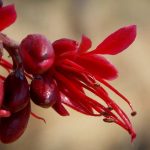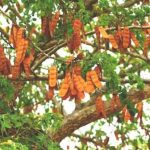TREE LIFE
July 1998
Subs ($60) for the year 1998/99 were due on 1st April. If you see a red dot on your Tree Life, it is to remind you that payment has not been received and that this will be the last issue that we can send you.
MASHONALAND CALENDAR
Saturday 4th July. Botanic Garden Walk. This month Tom concludes the series on the lowveld trees with the few species that we missed on earlier walks. We will meet Tom in the car park at 10.45 for 11 a.m. – There will be a guard for the cars.
Sunday 19th July. Ann and Nino Bianchi on Templeton Ranch near Banket will once again share their interesting trees with us. Bring a picnic lunch and enjoy a day away from town. We meet at 9.30.
Ann operates an indigenous tree nursery so this will be a good opportunity to buy (or perhaps place an order) for the species that you require.
Saturday 25th July. Mark’s Walk this month will be to Greengrove Nature reserve. Meet at 2.30 p.m.
Saturday 1st August. Botanic Garden Walk.
MATABELELAND CALENDAR
Sunday 5th July. Morning only visit to Hillside Dams – meet at the far car park at Hillside Dams. We will look at 2 or 3 species. Jonathan Timberlake will lead the walk.
August 8th – 12th. Visit to Nyoni Hills and Buchwa. You can still join this visit if you are interested please make contact with Anthon in Bulawayo.
CHRISTON BANK 17 MAY 1998
With the AGM safely tucked away for another year it was time to head into the Botanic Reserve on route for the Mazowe River. As members found out the path has a considerable gradient that is not obvious on the decent but painfully so on the ascent. However, any path taken through the reserve has this side effect but is worth following as this hillside contains a wide variety of habitats and therefore a larger number of tree species. Autumn along with the attractive colours of withering foliage is to me one of the most pleasant seasons, except for the grass which becomes enemy number one and this place is no exception with stiff barbed awns finding every single unprotected part to probe the skin.
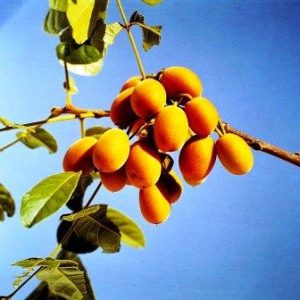
Zanha africana. Photo: Mike Bingham. Source: Flora of Zimbabwe
As usual, termite mounds hold a variety of plant species within their enriched soils and here a number of Zanha africana occur displaying an almost varnished underside to the leaves while under the peeling bark a red-brown colour is noticeable. Acacia goetzei subsp. microphylla, follow the perimeter of the termitaria and are mostly small and stunted. The leaves are short in length with narrow pinnae and the plant arms itself with short vicious curved spines. Other trees in this densely plant populated zone were fruiting Pappea capensis – the indaba tree, Commiphora mollis and various Combretum (we think) all tangled together. Orange flowers popping out from this tangle were belonging to something of interest, being Vernonia aurantiaca, which was kindly identified by Mark from a piece carefully plucked by Cheryl. According to Kirkia Vol.9 Part 1 this particular species differs from the more commonly occurring Vernonia spp., which are often small trees, by being a branching scandent shrub up to 8 metres in height when supported by other vegetation. Another major difference is the colour of the flower heads being this distinctive and attractive orange whereas the others vary from blue to purple and white. The original name dating from the turn of the century (and requiring the intake of breath) was Gongrothamnus divaricatus, so the more modern name referring to the flower colour is perhaps easier to remember and pronounce! This species has a wide distribution pattern having been recorded from Sessame in the Gokwe district, to Kwekwe and Shangani in the south and Mutare in the east, but does appear to prefer areas just below the watershed.
The Mazowe River meanders along the lower boundary of the reserve and as winter nears, is little more than a trickle. Its course is marked by tall riverine woodland, comprising large Celtis africana and some really large Combretum erythrophyllum which cast an almost permanent shadow but with the trees closest to the river being bent with age and the destructive tendencies of the river does create a gloomy atmosphere.
What a good idea to hold the AGM in the Botanic reserve and thanks to Meg Childes for suggesting it and for those who walked in vain looking for the mornings venue my apologies, I forgot the signs.
-Andy MacNaughtan
REPORT ON VISIT TO ZINDELE SAFARIS, SHUMBA SHABA LODGE MATOPOS SUNDAY 7 JUNE.
Nine members of the Matabeleland Branch of the Tree Society of Zimbabwe made the trip out to the property run and owned by Sandy and Denis Paul. Our apologies to Clem for not leaving Bulawayo early. We arrived at about 10 o’clock and were greeted by our hosts who arranged for tea to be made for us. While we were waiting we walked out to the edge of the Dwala to admire the magnificent view over the river valleys below Mtshabezi and Umzingwane.
After tea and a pleasant chat with our host we first had a look at one of the lodges, which is perched on the edge of the hill with a truly breathtaking view. We saw a total of 81 species of trees, shrubs and climbers. Aloe chabaudii was flowering beautifully where it had been planted here and there. Aloe greatheadii was just starting to flower.
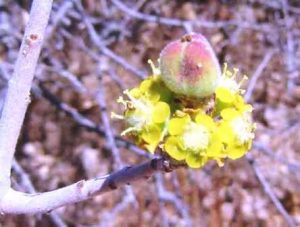
Euphorbia matabelensis. Photo: Bart Wursten. Source: Flora of Zimbabwe
Euphorbia matabelensis was in flower in more exposed positions below the lodge area going down the slope. Plants of particular interest were Acokanthera rotundata, some quite large specimens. Brachylaena rotundata very noticeable with their pale greyish green leaves. Erythroxylum emarginatum with their flattened bud tips. Ficus natalensis not often encountered in Bulawayo, looking very different from the more commonly (on our visits) seen Ficus thonningii. Clem recognised Hexalobus monopetalus. Mundulea sericea, some 15-18 footers were seen, and Ochna puberula with its very upright growth and small leaves.
An interesting find in a gully was a group of multi-stemmed Olinia vanguerioides. A number of large Schrebera alata were found and some very old-looking Tapiphyllum velutinum.
A few very tall Tarenna zimbabwensis nestled up against some of the boulders near the lodge. Vitex payos (the fruits were sweet) was scattered in a few places.
After returning to the camp for lunch some of our party decided to head back to town. The diehards continued plant hunting before going back to camp for tea and the trip back to town. We would like to thank Denis and Sandy most sincerely for allowing us to share with them their beautiful scenery and plants for the day.
-Anthon Ellert.
Wandering around Northern Malawi
Last year I spent quite some time in Malawi, most of it in the Northern Region in the District of Rumphi, Mzimba, Karonga and Chitipa (was Fort Hall), which proved to be very interesting as far as trying to identify various species of tree, not always successfully I’m afraid but nevertheless very interesting.
I managed to get hold of the Flora of Tropical East Africa volume on the Leguminosae, Part 11 Caesalpinioideae, which was very useful for identifying the many Brachystegia, Julbernardia and Isoberlinia spp. even if the introduction was most intimidating in describing the genus Brachystegia as difficult to identify, having many interspecific hybrids (but many more species to hybridise than in Zimbabwe) and “Chaotic”‘. Also very useful were Chapman and White’s The Evergreen Forest of Malawi Oxford Commonwealth Forestry Institute 1970 (Out of print but I managed to get a photocopy), Williamson J, Useful Plants of Malawi, Binns A, A Dictionary of Plant Names in Malawi, Government Printer Zomba and available.
The Miombo Woodlands
First let me talk about some of the woodland miombo species that I encountered. In tree species the miombo woodlands of Northern Malawi are very similar to the miombo woodlands of Zimbabwe, except that there are quite a number of extra species that occur, especially Brachystegia and the trees tend to be taller. Firstly Brachystegia manga, which mainly appeared to grow on hillsides, often in quite dry areas. It had quite large roundish leaflets and at first, because of this, I did not even think that it was a Brachystegia sp. It’s quite easy to recognise from far and near, especially when it covers hillsides, by the bluish colour of the foliage. According to Coates Palgrave it’s found in Zimbabwe along the Zambezi escarpment. It’s a very common tree in Northern Malawi often being the dominant species.
Brachystegia taxifolia, which is very easy to identify because of its very fine leaflets (they are actually more like the leaflets of an Acacia sp., than yew leaves). It is very common at medium to high altitudes and is the only Brachystegia species that I saw growing on the high Nyika, albeit very stunted, like some of the Nyanga Msasa in Zimbabwe.
Brachystegia longifolia is very common along the high rainfall areas bordering the Viphya Hills around Mzuzu where it was common with Brachystegia spiciformis and Julbernardia paniculata (of which more later). It is not unlike a large Msasa but with very much longer leaflets.
There was quite a number of Brachystegia spp. that I saw in Malawi that appeared very similar to Brachystegia spiciformis, which itself is much more variable than south of the Zambezi but some of the Brachystegia similar to Brachystegia spiciformis seen were, I think, other species. One of them, I think, was Brachystegia floribunda, which is a very common tree. The leaflets appeared very similar to Brachystegia spiciformis but the trunk was very smooth even where there was obviously fire (not unlike the trunk of Brachystegia glaucescens.) Brachystegia glaucescens, and Brachystegia boehmii were also very common and differed very little from Zimbabwean species.
Julbernardia paniculata was very common in the better rainfall areas e.g. around Mzuzu and a very large tree with big semi-glossy leaves not at all like Julbernardia globiflora. Both these two Julbernardia spp. in northern Malawi were flowering from April into May, which is quite a lot later than in Zimbabwe. Whilst on the subject of Julbernardia, I also saw Isoberlinia angolensis, which I doubt I would have recognised if it had not been in flower. The flowers are fairly similar to Julbernardia spp. (which was once included in the Isoberlinia genus) but much larger. It grew in mixed miombo or secondary miombo woodland.
On the slopes of the Nyika Plateau in the miombo woodlands there are a large number of Uapaca spp., including Uapaca kirkiana, Uapaca nitida and what I think from looking at FZ, Uapaca robynsii, which had very rusty colouring on the lower surface of the leaves. All Uapaca trees in the Tumbuka language of the Northern Region are called musuku, which is interesting as they are also called this in the Karanga dialect of Shona but I think they are mujanje in all the other dialects of Shona.
–Tackie Bannerman (To be continued)
BOTANIC GARDEN WALK: 6 JUNE 1998
On a bright winter’s morning, we looked first at the area between the car park and the lake, in which are to be found plants from the Victoria Falls area.
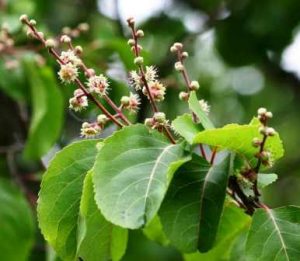
Homalium abdessammadii. Photo: Bart Wursten. Source: Flora of Zimbabwe
A very rare tree in Zimbabwe is Homalium abdessammadii. Indeed, Tom feels it may even be extinct in this country. It used to occur in riverine swampy backwaters above the Falls and may still persist in the rainforest itself. According to FZ, it is essentially a tree of riverine fringing forest and occurs in Zambia, Angola, Zaire and Tanzania. In appearance it is a bit like Flacourtia or Oncoba, with the alternate, somewhat glossy leaves with usually reddish petioles. This particular one was in flower; technically it differs from the other two Homalium spp. in Zimbabwe (Homalium chasei and Homalium dentatum) in having stamens in clusters of 3 before each petal; the others have solitary stamens.
Near to the lake, there is a fine specimen of a riverine tree, Syzygium guineense subsp. barotsense. This is a different subspecies of our woodland waterberry. Above the Falls it is a very common tree fringing the Zambezi. The bark is typically a pale whitish-grey and Tom mentioned that the large size of the purplish fruit was also another distinguishing feature.
Another Syzygium nearby was an example of a Syzygium cordatum / guineense hybrid. Tom stated that this arises quite often and whole groves of it can occur in suitable places.
Nearby was an extraordinary-looking Hibiscus. This is a woody species, the stem of which is densely covered in prickles and, unusually for Hibiscus the flowers are purplish. It is Hibiscus diversifolius subsp. rivularis and it occurs by lowveld rivers.
Other Falls species seen were Phoenix reclinata, Chionanthus battiscombei and the whorled dark green leaves and yellow sap of Garcinia livingstonei.
After our visit to the Falls we found ourselves looking at a species from low-altitude forest (up to 600 m according to FZ) in Mozambique. This is Cola mossambicensis, which occurs just out of Zimbabwe. Like Cola greenwayi in the Bunga Forest in the Vumba, it has a distinctive brown hairy swelling (a pulvinus) at the apex of the petiole below the leaf lamina and a similar one at the base of the petiole as well.
Towards the end of the walk, we saw four species which were of great interest and all new to me.
Croton pseudopulchellus occurs in western Zimbabwe, for example, on Kalahari sand in Hwange National Park. It also occurs elsewhere in lowveld situations, and is often associated with mopane. It is an unusual Croton (and indeed unusual for the Euphorbiaceae) in having sub-opposite or whorled leaves. In a recent write-up we discussed Excoecaria madagascariensis, another Euphorbiaceae with opposite leaves.
Hymenocardia ulmoides. Tom offered a generous bet that no one would know what this was and he was right! This is a rather rare species occurring in the SE of Zimbabwe, specifically in Gonarezhou and in the drier parts of the Haroni-Rusitu area. Like the commoner Hymenocardia acida (which we still don’t see all that often) it has winged fruit and glands on the underside of the leaf.
Suregada zanzibariensis. This is another species from the Euphorbiaceae. It occurs at low altitudes south of the Lundi in Brachystegia glaucescens woodland where it forms an evergreen understorey. The leaves are alternate and have a somewhat rugose upper-surface. The other species of Suregada, namely Suregada procera, occurs in the Chirinda forest.
Galpinia transvaalica. This opposite-leaved small tree is rare in Zimbabwe, having been recorded from the Mateke Hills in S. Zimbabwe and more recently from Gonarezhou. It belongs to the family Lythraceae, which in the Zimbabwean native flora consists entirely of herbs, which occur mostly in or near water. In gardens, however, the Pride of India, Lagerstroemia indica belongs to the same family and is also a woody plant. Galpinia has flowers in terminal panicles – but at this time of the year they were in fruit.
Once again, an extraordinarily interesting morning. Our thanks go to Tom for so regularly leading us around the Gardens.
-Mark Hyde
NOTES FROM THE LAY-BYS
There are not too many places you can go to in Zimbabwe, and even fewer in South Africa, if you are trying to escape Acacia karroo (sweet thorn). To see what I mean, look at the distribution maps of this species in Coates Palgrave or van Wyk and van Wyk. On a recent (Feb-March) holiday to the Eastern Cape we saw flowering Acacia karroo all the way from Harare to Kenton-on-Sea, some 25km down the coast from port Alfred. Our route took us along the direct road to Beitbridge and Messina, where we spent a few days, then to Pietersburg and Pretoria via the Waterpoort – Vivo – Dendron bypass of Louis Trichardt. From Pretoria we travelled down the N1, N3, N5, and R26 to Harrismith and Ficksburg in the Free State, and from there, skirting Lesotho, through Aliwal North, Queenstown, Stutterheim, King William’s Town, and Grahamstown to Kenton. Even in the largely treeless Free State there was Acacia karroo in flower.
Our return journey took us up the coast to East London, hardly ever out of sight of flowering Acacia karroo, and from there back to Ficksburg via Stutterheim, Queenstown, etc. From Ficksburg we headed for the N1 at Kroonstad via Rosendal, Senekal, and Steynsrus, then straight up the N1 to Pretoria. Wherever there were trees we could be sure to see flowering Acacia karroo. During our stay in Pretoria we spent a day at the Haartebeespoort Dam, and there it was again – everywhere.
So if you really want to get away from Acacia karroo…!
-Lyn Mullin. (To be continued)
NYARUPINDA CATCHMENT May 10, Brouseland, Mashonaland West
Hello Old Bean, Howzitt? Long-time no (faybay)see. Those inoculations did the trick I hope, whole family happily nodulating, round ones and long ones too. This will keep the old nitrogen cycle spinning along; try not to wobble when you sing.
The boffins are saying that round nodules are helping them to sort out a pedigree of leguminous tribes in the jungle of classification; long nodules have twice as many chromosomes as their host plant, round ones have the same number as the rest of the plant.
Have you heard that Acacia laeta is in pod in the Southern lowveld, her offspring may be the 17 007th species of legume in the world?
Bumped into cousin Calpurnia the other day, poor dear hasn’t a bean but she looks a million. Des modium and I were all agog when we saw Brachystegia allenii growing at the altitude of nearly 4000ft asl on a stony quartz hillside barely a quarter of a mile from our house. Must have been past this tree dozens of times without seeing it. Must look for more. “mturu” is in my drawing book, illustrated natural size, collected at Dyffryn, Victory Block. Altitude 3400ft asl. Drawn 7/3/76. What is Escarpment Brachystegia doing here? First thing today the gardener showed us a 4 day-old civet midden inside the vegetable garden. Can you believe it? I tell you the wild life comes to see us. The civetry was near the Yard-Long-Bean (Vigna sesquipedalis) trellis. The scats contained guavas, wads of grass and Donkey berries.
In January we visited another world, the valley of the Limpopo. Never expected to see Kirkia acuminata flanked with pink sandstone. Rather stunted Cassia abbreviata in fruit didn’t seem right growing on level ground, no termite mounds for miles around, too dry. Tough luck, for game and livestock; mounds offer a variety of delicacies for browsers, succulent leaves and shoots rich in minerals, vitamins and trace elements in spring when the veld is most arid and waiting for the rain to bring on the patches of grass. Game seek the shelter of mound vegetation to protect them from the sun and wet ground, there is warm lying in winter.
Three metres of dead python made the pulse beat faster. Found it on the alluvium under the Fever Berry trees.
Wood collection is ongoing; thinning of a Tamarind tree made samples; Mundulea du Plessis of Bakwe farm Raffingora presented me with a fine little wide-necked vessel which he had turned, made of Dodonaea angustifolia, a study in brown, the bark, and white wood. Dalbergia Kempthorne said “it’s more use to you than to me,” he referred to a flat-sawn piece of munyi, Berchemia discolor, very hard dark brown heartwood and yellow sapwood, one of the heaviest samples on the shelves. This gift is on a par with the sawn piece of Red ivory, Berchemia zeyheri given me by Chamfuti Cant long ago, commercially this wood is one of the rarest in the world.
Looking forward to hearing your news, views and aspirations, when are you coming to see us? Posts all bug-house, phones out of order, I’ll expect your reply by bearer with cleft stick. The cost of stamps will ruin all of us this coming Christmas.
Salaams to you dear Bean and Aeschynomene in her sunspecs, and the little Chick Peas.
Yours ever Indigofera.
P.S. The table of foodstuffs might interest you; you must not feel over-faced by the figures, it only needs a small mathematical sum to find the nutritive ratio: %protein is divided into the sum of the % of fibre and carbohydrate and the % fat (Ether Extract) is multiplied by 2.3. The result is written e.g. maize 1: 9.2 meaning 1 part protein to 9.2 parts of other ingredients in the food. Ash means minerals. Crude protein always reminds me of Boerewors; however some species are pleasantly digestible.
The source of the food chart was Mr. L.T. Tracey’s book written at Chakari and published in 1945, the title Approach to Farming in Southern Rhodesia. This book was specially prepared for ex-servicemen who were being trained to be farmers and stockmen, after the 2nd World War. Home-grown protein was the slogan, to balance the production of maize in the rotation of crops by including green manure crops and legumes.
One final thought, we must not despise Carob just because we know that it is used to economise in the preparation of cocoa powder. Carob is made from the fruits of the locust tree, indigenous to Mediterranean countries. Its seeds and pods are known at St John’s bread. A natural sweetener contains pectin, plenty of calcium and no caffeine, use it as flour or powder and reduce the amount of sugar.
Numbers 1, 2, & 11 have present names. Vigna sesquipedalis is worth growing, the pod almost cylindrical and about ½ inch in diameter. Maureen Silva-Jones has a few precious seeds if someone would like to try it, no trouble to grow.
-Benedicta Graves
ANDY MACNAUGHTAN CHAIRMAN


